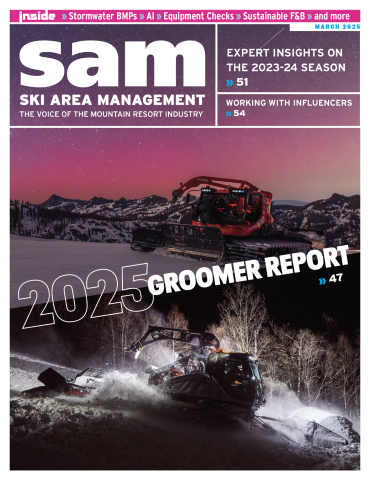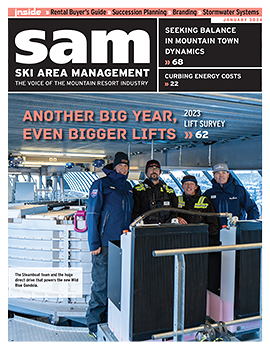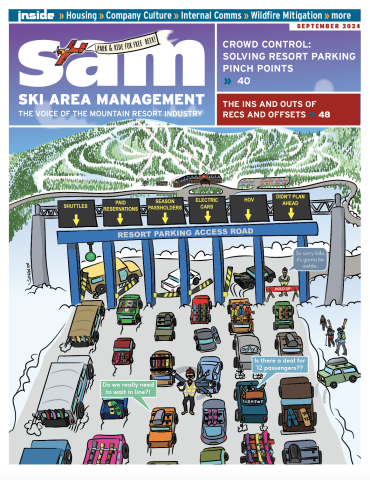DON’T CHANGE TIME——SHIFT THE WORKDAY
The problem, senator, is that there are only so many (daylight) hours in a winter’s day.
A Colorado Senate committee unanimously approved a bill that would put Colorado on daylight saving time (DST) year-round, and Colorado Ski Country USA (CSCUSA) isn’t happy about it. The senator behind the bill said Coloradans would revel in the extra hour of afternoon daylight and outdoor recreation, but CSCUSA is more concerned with how the time change would affect mornings at resorts during their peak winter season.
"It'll cut an hour out of our operating time," says Melanie Mills, president and chief executive of CSCUSA. The extra hour of darkness in the morning would push avy control and other pre-opening work to later in the morning. As it is, sunrise isn’t until 7:30 a.m. MST or later at many Colorado areas during December and January, and on north-facing mountainsides, there’s not much light for a good while after that. Even on standard time, it’s hardly light enough to ski by 8:30, and most resorts don’t open till 9. DST would push that up to 10.
Of course, areas could use the extra hour of daylight in the afternoons to stay open an hour later. But think about all the other consequences of year-round DST. Why should we reward those lazy heads who can’t drag themselves out of bed for first chair at 9 on a powder day? And who in his right mind would cut an hour from our afternoon hot-tub and après time? Life gets complicated once you start screwing around with time.
IS THERE AN ECO-GROOMER IN YOUR FUTURE?
There is if Dan Osborne has anything to say about it. Osborne is chief developer of the EcoGroomer, which essentially adds two tiller bars in a V formation behind a single cat, doubling or tripling the grooming capacity of a single cat. Osborne says that this arrangement works on most novice and intermediate terrain, or about 60 to 70 percent of a typical area’s acreage.
“This technology has the potential to save over 20 million gallons of diesel fuel for the U.S. ski industry alone by 2020 and will save major resorts significant amounts of capital and other resources,” Osborne says. Fuel efficiency gains can be up to 40 percent, and a single cat can become 200 to 300 percent more efficient, he claims.
Osborne is working with both Prinoth and Kässbohrer to advance the concept and hopes to have prototypes working with groomers from both companies by next winter, if not this summer. He believes the Eco-Groomer could be retrofitted to most machines with at least 350 hp, including the PB 600 and the Prinoth Bison. He hopes to have the final product available for 2013.
HALFPIPE, WOMEN’S JUMPING IN OLYMPICS
The 2014 Olympics in Sochi, Russia, will feature six new events, including ski halfpipe (men and women) and women’s ski jumping. The decision to add these and other events was based on ”universality, gender equity and youth appeal.” Five other events, including both snowboarding and ski slopestyle, for both men and women, are still under consideration. A decision on them is expected soon.
Helmet Law to Take Effect in New Jersey
New Jersey will have the honor of being the first state to enact a helmet law for skiing and riding. The New Jersey helmet bill (S. 130) passed both houses in the state legislature this winter, and Gov. Chris Christie signed it April 7. The law takes effect Nov. 1, in time for the 2011-12 ski season.
Mountain Creek, along with NSAA, NJ Brain Injury Association, and National Ski Patrol, worked with state legislators to help craft a workable bill. “I’m glad we had a hand in it,” says MC’s Bill Benneyan. “Early versions were impractical.” The law requires helmets for skiers and snowboarders under the age of 18, and, as with laws for bike helmets, makes individuals and parents responsible for enforcement. There’s a $25 fine for a first offense, and $100 for subsequent infractions. The law explicitly states that “[n]othing in this act shall be construed to extend liability to the ski area operator.” The bill could thus be a fitting model for other states.
READING THE 2010 CENSUS TEA LEAVES
The U.S. population, and the winter sports business, are becoming less and less white—on several levels. Change is in the wind, as both the NSAA Demographic survey and the 2010 census show.
Total ski-area visits by non-white skiers and riders rose only slightly, from 10.7 percent to 13 percent, from 2000 to 2010, David Belin of RRC Associates tells us. But the real movement has been in the 25- to 34-year-old group (which was already the age group with the highest non-white percentage). That has gone from 15.3 percent to 19.8 percent. There have been smaller increases in the 35 to 54 and 18 to 24 age groups; oddly, percentages have been steady for both those 17 and under and 55 and over.
The question is, will the industry see those 25- to 34-year-old non-white participants continue to stick with the sport(s), or will they drop out as they get “older” (35 and over)? And, as always, what can ski areas do to keep non-white participants not only interested in trial, but maintain involvement as they get older?
That’s a key question, because the 2010 census shows Hispanics now total more than 50 million in the U.S. and comprised 56 percent of the total population increase from 2000. In fact, minorities account for nearly 85 percent of the decade’s population growth. For our sports to grow, they must become less white.
On a local level, Hispanics are becoming a larger part of the ski-town population. In both Truckee, Calif., and Blaine County, Idaho (home of Sun Valley), Hispanics make up 19 and 20 percent of the populations. That could be an important source of skiing and riding role models.
On a broader level, the 2010 census also confirms that Americans have been migrating from the older, larger cities (and their suburbs) in the Northeast and Midwest to the South, Southwest, and Mountain West states. The net effect is to put more of the population further away from winter resorts. That shift makes local learn-to efforts even more critical for resorts in areas that are losing population, and puts a greater burden on destination resorts to attract and retain customers from regions with growing populations—and with less personal connection to winter.
ELWAY TOUCHES DOWN IN VAIL
Colorado’s most famous celebrity and his restaurant partners are looking to open an Elway's steakhouse, their third, in Vail in time for the 2011 holiday season. Former Broncos great John Elway and his group hopes to repeat the success of the first two, including the original in Cherry Creek and another in the Ritz-Carlton Denver.
WINTER SPORTS ATHLETES RULED IN 2011
With the conclusion of the various World Cup, Grand Prix, X Games, and other competition series, U.S. athletes once again peppered the top ranks. Lindsey Vonn missed her fourth overall World Cup by just three points, but still won the individual titles in downhill, super G, and combined. The miss was especially hard since it came down to a final race, which was canceled due to weather. Ted Ligety was the World Cup GS champion, and took the World Championship gold, becoming one of only five other American athletes to have won both Olympic and World Championship gold.
Hannah Kearney took the women’s World Cup moguls title, having won an astounding nine events over the course of the year, and earned the FIS Freestyle World Cup overall title.
Alex Schlopy won the first-ever World Championship gold in slopestyle skiing in Park city, and topped that off by winning the X Games big air competition. Devin Logan won the U.S. Freestyle Championships women's halfpipe skiing event, and also won her first X Games medal, silver in women's halfpipe skiing at Euro X Games. David Wise earned his third U.S. halfpipe title in four years.
In snowboarding, Kelly Clark took Euro X Games gold as did Louie Vito, marking his first X Games win. Clark also won the Dew Tour final as she and Vito took season titles. Shaun White once again took gold in men's Winter X halfpipe snowboarding. Lindsey Jacobellis won her fourth X Games SBX title as well as the U.S. Snowboarding Grand Prix title. Jonathan Cheever took U.S. SBX while Nick Baumgartner reigned at the X Games.
In cross country, World Cup sprint specialist Kikkan Randall won two World Cup sprints and finished third overall in the discipline.
SHORTSWINGS
It’s the end of an era at Alta. Alan Engen, head of Alta ski school and son of legendary skier and teacher Alf Engen, retired at the end of the 2011 season. This leaves Alta without an Engen working there for the first time since 1948. . .
Browse Our Archives
News Search
May 2011
Blue Pages :: May 2011
DON'T CHANGE TIME--SHIFT THE WORKDAY... IS THERE AN ECO-GROOMER IN YOUR FUTURE?... HALFPIPE, WOMEN'S JUMPING IN OLYMPICS... HELMET LAW TO TAKE EFFECT IN NEW JERSEY... READING THE 2010 CENSUS TEA LEAVES... ELWAY TOUCHES DOWN IN VAIL... WINTER SPORTS ATHLETES RULED IN 2011... SHORTSWINGS
Written by: Staff- Push to The Latest: No
- Show in The Latest?: No
SEARCH BY YEAR/ISSUE
- 2025
- 2024
- 2023
- 2022
- 2021
- 2020
- 2019
- 2018
- 2017
- 2016
- 2015
- 2014
- 2013
- 2012
- 2011
- 2010
- 2009
- 2008
- 2007
- 2006
- 2005
- 2004
- 2003
- 2002
- 2001
- 2000
- 1999
- 1998
- 1997
- 1996
- 1995
- 1994
- 1993
- 1992
- 1991
- 1990
- 1989
- 1988
- 1987
- 1986
- 1985
- 1984
- 1983
- 1982
- 1981
- 1980
- 1979
- 1978
- 1977
- 1976
- 1975
- 1974
- 1973
- 1972
- 1971
- 1970
- 1969
- 1968
- 1967
- 1966
- 1965
- 1964
- 1963
- 1962

















